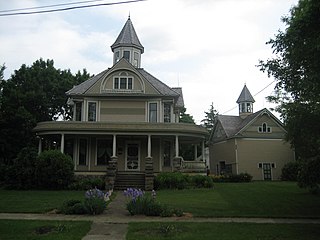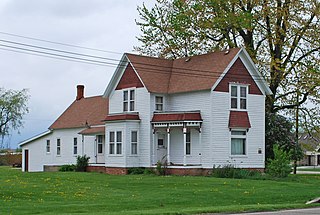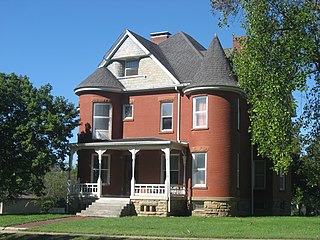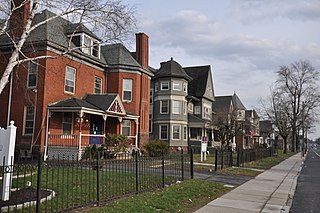
The Joseph W. Baldwin House is a historic residence in the city of Wyoming, Ohio, United States. Erected in the late nineteenth century, it was originally the home of a wealthy Cincinnati businessman, and it has been designated a historic site because of its distinctive architecture.

The Stephen Decker Rowhouse is a historic multiple residence in the Columbia-Tusculum neighborhood of Cincinnati, Ohio, United States. Built in 1889, it occupies land that was originally a portion of the wide vineyards of Nicholas Longworth. In 1869, after his death, Longworth's estate was platted and sold to builders who constructed a residential neighborhood along Tusculum Avenue. One of the most unusual buildings was the Decker rowhouse, which features multiple distinctive Victorian elements. Chief among these is the ornamentation on the porch roofs: they include gabled rooflines and beveled corners supported by multiple spindles. Connecting these porch roofs are low normal roofs, which primarily protect the recessed entrances to the houses. Elsewhere, the houses feature double-hung windows, imbricated shingles on the gables, and arcades of Gothic Revival panelling, and numerous ornamental circles inscribed within squares. Taken as a single building, the rowhouse measures two bays wide and eighteen bays long; it is of frame construction and two stories tall. Rated "outstanding" by an architectural survey in 1978, it is the only rowhouse of its type in Cincinnati, due to its well-preserved Victorian architecture.

The LuNeack House is a historic residence in the Columbia-Tusculum neighborhood of Cincinnati, Ohio, United States. Built in 1894, it is a frame building with clapboard walls, two-and-a-half stories tall. The overall floor plan of the house is that of a rectangle, with the front and rear being the shorter sides, although the original shape has been modified by the extension of the rear and a hexagonal bay on the western side.

The Norwell Residence is a historic house in the Columbia-Tusculum neighborhood of Cincinnati, Ohio, United States. A Victorian building constructed in 1890, it is a weatherboarded structure with a stone foundation and a shingled roof. The overall floor plan of the house is irregular: two and half stories tall, the house is shaped like the letter "L" but appears to be a rectangle, due to the presence of two separate porches that fill in the remaining area. Many ornate details characterize it, including imbricated shingles on the westward-facing gable end of the house, a frieze with spindles on the railing of the primary porch, and small yet cunningly crafted braces for the same porch. Yet more distinctive is the secondary porch, which sits atop the primary one; it features braces and spindles similar to those of the primary porch.
There are several historic homes in the United States which bear the name Colson House, spanning the century from ca.1800 to 1905.

The Lucien Boneparte Covell House is a historic house located in the village of Richmond, Illinois, USA. The house is an example of Queen Anne style architecture and was built in 1905. The Covell House was listed on the U.S. National Register of Historic Places in 1989.

11 Beach Street in Reading, Massachusetts is a modest Queen Anne cottage, built c. 1875-1889 based on a published design. Its first documented owner was Emily Ruggles, a prominent local businesswoman and real estate developer. The house was listed on the National Register of Historic Places in 1984.

Queen Anne style architecture was one of a number of popular Victorian architectural styles that emerged in the United States during the period from roughly 1880 to 1910. Popular there during this time, it followed the Eastlake style and preceded the Richardsonian Romanesque and Shingle styles.

St. Louis Catholic Church is a historic Roman Catholic church in North Star, Ohio, United States. Constructed in the early twentieth century, it is one of the newest churches in a heavily Catholic region of far western Ohio, but it has been recognized as a historic site because of its unique architecture.

142 Collins Street is an architecturally distinguished Queen Anne Victorian house in Hartford, Connecticut. Built about 1890, it is typical of houses that were once much more common the city's Asylum Hill neighborhood. It was listed on the National Register of Historic Places on November 29, 1979.

The John and Edna Truesdell Fischer Farmstead is a private farm, including house and outbuildings, located at 4896-5228 Sheldon Road in Canton Township, Michigan. The 1897 Queen Anne farmhouse located on the site is also known as the Michael and Catherine Hasselbach Fischer House. It was listed on the National Register of Historic Places in 2000.

St. Sebastian's Catholic Church is a historic Roman Catholic church in Marion Township, Mercer County, Ohio, United States. Located in the unincorporated community of Sebastian, it is the home of an active congregation and has been declared a historic site because of its well-preserved early twentieth-century Gothic Revival architecture.

The Nativity of the Blessed Virgin Mary Catholic Church is a historic Catholic church in Cassella, an unincorporated community in Mercer County, Ohio, United States. One of several Catholic churches in Marion Township, it has been designated a historic site because of its well-preserved nineteenth-century architecture.

The W. S. Salmon House in southeast Portland in the U.S. state of Oregon, is a 2.5-story apartment house listed on the National Register of Historic Places. Built in the Queen Anne style in 1890, it was added to the register in 1994.

The Alfred Webb Investment Properties in southeast Portland in the U.S. state of Oregon consists of four Queen Anne cottages listed on the National Register of Historic Places. Built in 1891, they were added to the register in 1989.

Lawler's Tavern is a historic commercial building in the village of Mechanicsburg, Ohio, United States. Built in 1830, it is one of the oldest buildings in the community, and it has been named a historic site.

The Chalon Guard and Emma Blades Cloud House is a historic house located at 300 S. Washington St. in McLeansboro, Illinois. The house was built circa 1892 for Chalon Guard Cloud, who ran the Cloud State Bank with his father Aaron, and his wife Emma Blades Cloud. The house's design features a distinctive blend of architectural styles; while primarily designed in the Queen Anne style, it also includes elements of the Shingle and Romanesque styles. The house is built of red brick with a limestone foundation; the brick masonry walls of the house are characteristic of Richardsonian Romanesque architecture and represent the only residential use of the style in McLeansboro. Two conical turrets mark the front corners of the house; two other turrets are located on the south side of the home. A large roof gable, which connects to the top of the smaller southern turret, is sided in slate-colored shingles typical of the Shingle Style. The house's front porch, which was added in the early 20th century, features turned columns and a spindlework railing. The house's multi-component roof features several cross gables and three brick chimneys.

Robert Nancy Monroe House is a historic home located near Silver Hill, Scotland County, North Carolina, USA. It was built in 1912, and is a 1½-story, three bay by three bay, Queen Anne style frame dwelling. It has a tall truncated-hip roof covered with decorat1ve metal shingles and pierced by two large, heavily corbeled, interior brick chimneys. It features a wrap-around porch with Tuscan order columns, imbricated wood shingles on its gables, dormers, and a three-stage rear tower.

The Parkside Historic District encompasses a fine collection of Queen Anne Victorian houses lining the east side of Wethersfield Avenue north of Wawarme Avenue in southern Hartford, Connecticut. This area was developed in the 1880s and 1890s by Mrs. Elizabeth Jarvis Colt, widow of arms manufacturer Samuel Colt, out of a portion of their extensive estate. Of this development, a row of nine houses now remains; it was listed on the National Register of Historic Places in 1984.

The Almond A. White House is a historic house in Motley, Minnesota. Built in 1902, the Queen Anne architecture is unique compared to other buildings in the town, and locally, it is referred to as the Motley Castle. Believed to be built as a rural retreat for Mr. A.A. White, a lumber businessman, the house remains a showplace in Motley, and was added to the National Register of Historic Places on March 13, 1986.






















